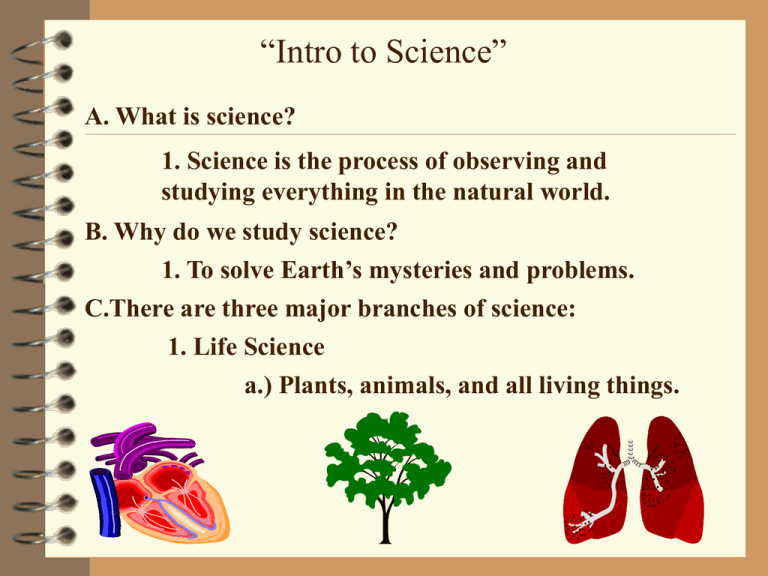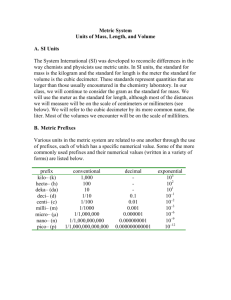Intro to Science/Metric System
advertisement

“Intro to Science” A. What is science? 1. Science is the process of observing and studying everything in the natural world. B. Why do we study science? 1. To solve Earth’s mysteries and problems. C.There are three major branches of science: 1. Life Science a.) Plants, animals, and all living things. 2. Physical Science a). Chemistry & Physics 3. Earth & Space Science a.) Earth’s surface, weather, ocean, and space. D. The four major branches of Earth & Space Science: 1. Geology - The study of Earth’s origin, history & structure. 2. Meteorology - The study of Earth’s atmosphere, weather, & climate. 3. Oceanography - The study of Earth’s oceans. 4. Astronomy - The study of the position, composition, size and other characteristics of everything outside of Earth’s atmosphere. “The Scientific Method” A. What is the scientific method? 1. The scientific method is a systematic approach to solving scientific problems. B. Terms you need to know when using the scientific method. 1. Hypothesis- A proposed solution to a problem. 2. Theory- A logical explanation for an event that occurs in nature. 3. Law- A theory that is accepted as fact over many tests. 4. Variable- The factor being tested in an experiment. 5. Control- An experiment run without a variable. The Steps of the scientific method! 1. Identify or state the problem. 2. Gather information on the problem. 3. Form a hypothesis. 4. Run the test or experiment. 5. Record & analyze your data. 6. State your conclusion. 7. Repeat your experiment if necessary. 100 80 60 East 40 West 20 North 0 1st Qtr 2nd Qtr 3rd Qtr 4th Qtr “The Metric System” A. Why do we need to learn the metric system? 1. So scientists can communicate with each other. 2. One universal language. B. The metric system is a decimal system. 1. Our money system is an example of a decimal system. “Types of Metric Measurements” A. Length- How long or wide something is. 1. The meter (m) is used to measure length when using the metric system. 2. How do you use the prefixes? a.) 1000m = ________1________km b.) 100m = ________1________hm c.) 10m = ________1________dam d.) .1m = ________1________dm e.) .01m = ________1________cm f.) .001m = ________1________mm B. Mass- The measure of the amount of matter in an object. 1. The gram (g) is used to measure mass when using the metric system. 2. How do you use the prefixes? a.) 1000g = ________1________kg b.) 100g = ________1________hg c.) 10g = ________1________dag d.) .1g = ________1________dg e.) .01g = ________1________cg f.) .001g = ________1________mg C. Volume- is the amount of space an object takes up. 1. The liter, or cubic centimeter, (l or cm3) is used to measure volume when using the metric system. 2. Volume can be found three different ways, depending on what type of substance you are measuring. a.) For solid square objects you multiply the length x the width x the height of the object. b.) For liquids use a graduated cylinder. c.) For solid non-square objects use water displacement. 3. How do you use the prefixes? a.) The same as the other measurements! D. Density- is the amount of mass in the space a specific object takes up. 1. Grams per cubic centimeter (g/cm3) or grams per milliliter (g/ml) is used when measuring density in the metric system. 2. Density is measured by using the following formula: mass Density = _______________ volume OR g D = _______________ cm3 or ml E. Temperature- how hot or cold a substance is. 1. Temperature can be measured three different ways. 2. When using the metric system temperature is measured in degrees Celsius. a.) The boiling point = 100 degrees C b.) The freezing point = 0 degrees C 3. When using the standard system temperature is measured in degrees Fahrenheit. a.) The boiling point = 212 degrees F b.) The freezing point = 32 degrees F 4. When using the Kelvin system temperature is measured in Kelvin’s a.) The boiling point = 373 degrees K b.) The freezing point = 273 degrees K Metric SI Kelvin 10 50 400 9 45 380 8 40 360 7 35 340 6 30 320 5 25 300 4 20 280 3 15 260 2 10 240 1 5 220 0 0 200



